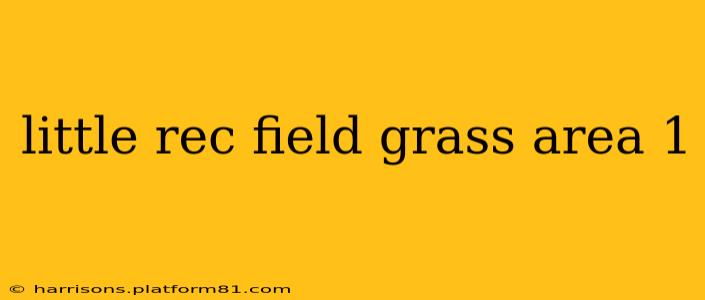Little Rec Field Grass Area: Maximizing Your Small Space
Creating a thriving and enjoyable recreational field, even in a small space, is achievable with careful planning and the right approach. This guide tackles the challenges and opportunities of designing and maintaining a mini recreational field, focusing on grass health and overall usability.
What are the best grass types for a small recreational field?
Choosing the right grass is paramount. Consider your climate, sunlight exposure, and usage levels. For high-traffic areas, a durable and wear-tolerant grass is essential. Some excellent options include:
- Tall Fescue: This cool-season grass is highly shade-tolerant and resilient to wear and tear. It’s a fantastic choice for areas with moderate to high foot traffic.
- Perennial Ryegrass: Another cool-season grass known for its rapid growth and excellent recovery from damage. Ideal for areas that receive full sun.
- Zoysia: A warm-season grass, Zoysia is incredibly durable and drought-tolerant. It’s slow-growing, requiring less mowing, but prefers full sun.
- Bermuda Grass: Another warm-season option, Bermuda grass thrives in hot, sunny conditions and is extremely resilient. However, it requires more maintenance than Zoysia.
The best choice will depend on your specific conditions; consult your local gardening center for expert advice tailored to your region.
How much space do I need for a small recreational field?
There's no definitive answer to this; it depends entirely on what activities you intend to support. A small area suitable for casual games like frisbee or a child's play area could be as small as 20x20 feet (400 square feet). However, if you envision more extensive games, you'll need a considerably larger space. Consider the minimum dimensions for the activities planned – a simple sketch can help visualize the space requirements.
What kind of soil is best for a small recreational field?
Healthy soil is the foundation of a lush, thriving lawn. A well-draining soil with a neutral pH (around 6.5-7.0) is ideal. Conduct a soil test to determine your soil's composition and adjust it as needed. Amend heavy clay soils with organic matter (compost) to improve drainage and aeration. Sandy soils may need amendments to increase water retention.
How do I maintain the grass in a small recreational field?
Maintaining a small recreational field requires regular attention, though the effort is typically less than maintaining a larger area. Key maintenance steps include:
- Regular Mowing: Mow at the correct height for your chosen grass type, ensuring sharp blades to prevent tearing.
- Watering: Water deeply but infrequently, encouraging deep root growth. Avoid frequent, shallow watering.
- Fertilizing: Use a fertilizer formulated for your grass type and follow package directions. Over-fertilizing can damage the grass.
- Weed Control: Identify and address weeds promptly. Regular mowing, proper fertilization, and healthy soil help minimize weed growth.
- Aeration: Periodic aeration can improve soil drainage and air circulation, promoting healthy root growth. This is especially beneficial in high-traffic areas.
What are some budget-friendly options for creating a small recreational field?
Creating a budget-friendly recreational field involves smart planning and resourcefulness. Consider:
- Source grass seed or sod locally: Buying in bulk or during off-season sales can save money.
- Use compost or other organic amendments from your own yard or local sources: This significantly reduces costs compared to buying bagged soil amendments.
- Perform maintenance tasks yourself: This eliminates labor costs.
- Start small: Begin with a smaller area and expand gradually as your budget allows.
By following these guidelines, you can transform even the smallest space into a vibrant and enjoyable recreational field. Remember to prioritize soil health, choose the right grass type for your conditions, and establish a consistent maintenance routine for long-term success.
